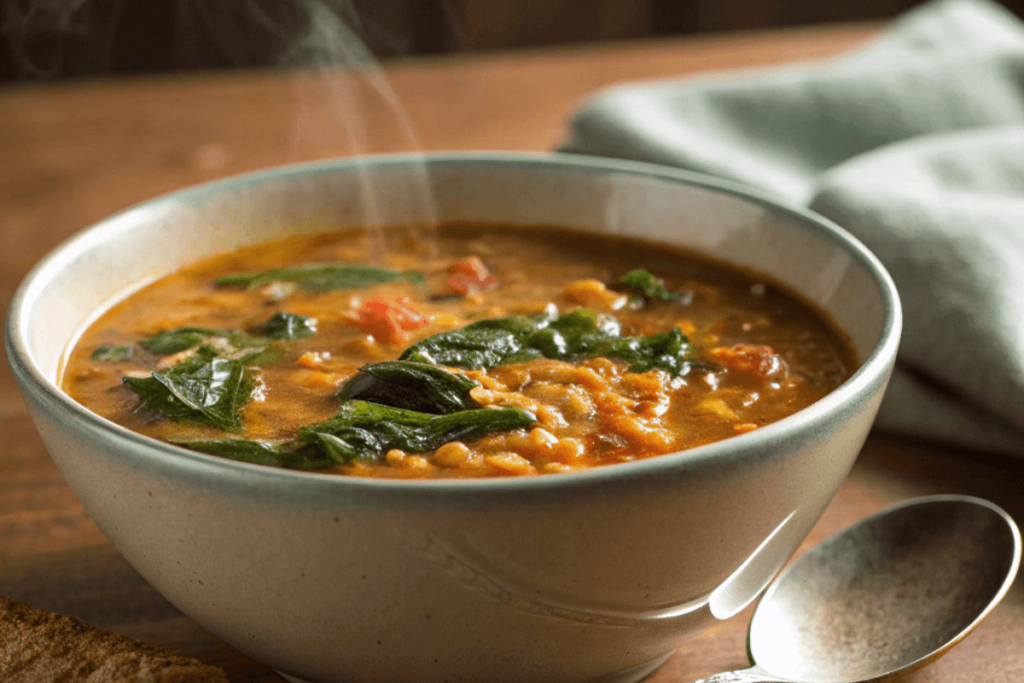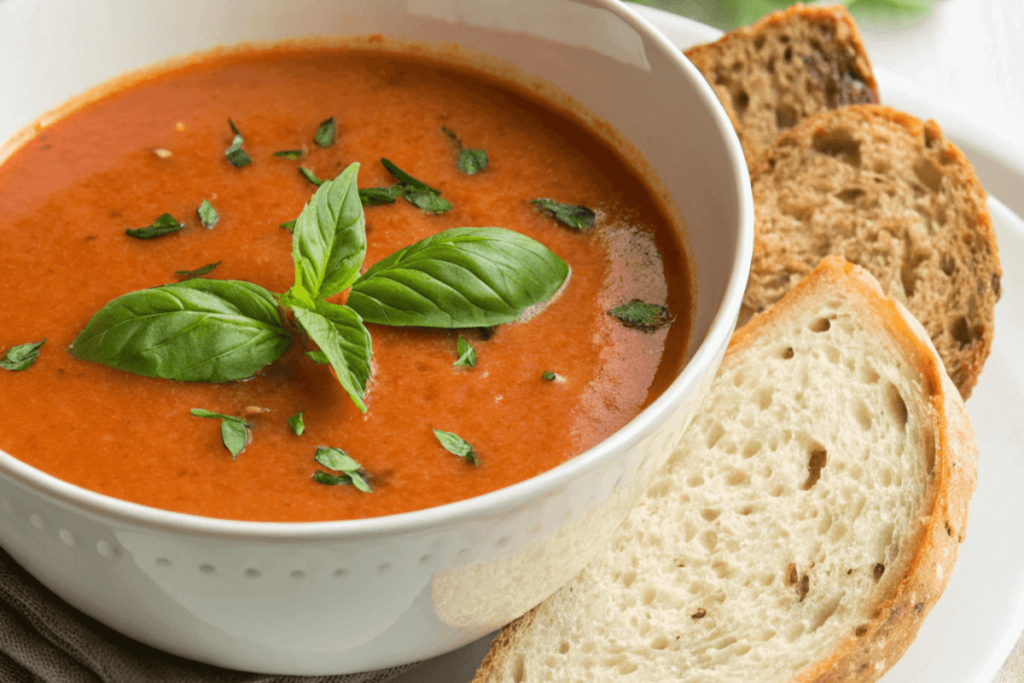Discover 10 delicious and easy low-calorie soup recipes perfect for weight loss lunches. Stay healthy, satisfied, and on track with these flavorful meal prep ideas.
Table of Contents
Why Soups Are Perfect for Weight Loss Lunches
When it comes to shedding pounds, soups are a secret weapon in your culinary arsenal. As someone who’s battled with weight loss, I can attest to the power of a good bowl of soup. Here’s why they work so well:
- Satiety without excess calories: Soups are inherently filling due to their high water content. This means you can eat a satisfying volume of food without consuming too many calories. I’ve found that starting my lunch with a bowl of soup often leads to eating less overall during the meal.
- Nutrient-dense ingredients: Most soup recipes are packed with vegetables, lean proteins, and fiber-rich ingredients. These nutrients are essential for maintaining energy levels and supporting overall health while you’re in a calorie deficit.
- Hydration boost: Many of us don’t drink enough water throughout the day. Soups can help increase your fluid intake, which is crucial for metabolism and can help reduce water retention.
- Customizable for dietary needs: Whether you’re following a low-carb, vegetarian, or gluten-free diet, soups can be easily adapted to fit your nutritional requirements.
- Meal prep-friendly: You can make a large batch of soup and portion it out for the week, making it an ideal option for busy schedules.
To maximize the weight loss benefits of soup, focus on broth-based varieties rather than cream-based ones. Incorporate a variety of vegetables for fiber and nutrients, and add lean proteins like chicken, turkey, or legumes to keep you feeling full longer.
Here’s a pro tip I’ve learned: Use aromatic herbs and spices liberally. They add tons of flavor without calories and many, like ginger and turmeric, have anti-inflammatory properties that can support overall health.
Remember, while soups are excellent for weight loss, they should be part of a balanced diet. Pair your soup with a small side salad or a piece of whole-grain bread for a complete meal that will keep you satisfied until dinner.
Top 10 Low-Calorie Soup Recipes to Try
- Spicy Lentil and Spinach Soup

- Calories per serving: 180
- Key ingredients: Red lentils, spinach, tomatoes, cumin, chili flakes
- Why it works: High in protein and fiber, this soup keeps you full for hours. The spices boost metabolism and add flavor without calories.
- Classic Tomato Basil Soup

- Calories per serving: 120
- Key ingredients: Fresh tomatoes, basil, garlic, low-fat milk
- Why it works: Rich in lycopene and vitamin C, this soup is comforting and supports immune health.
- Zucchini and Leek Soup

- Calories per serving: 95
- Key ingredients: Zucchini, leeks, vegetable broth, thyme
- Why it works: Low in calories but high in volume, this soup is perfect for filling up without overdoing it.
- Ginger Carrot Soup
- Calories per serving: 110
- Key ingredients: Carrots, ginger, turmeric, coconut milk (light)
- Why it works: Ginger and turmeric are known metabolism boosters, while carrots provide essential vitamins.
- Chicken and Vegetable Soup
- Calories per serving: 150
- Key ingredients: Chicken breast, mixed vegetables, herbs
- Why it works: High in protein and low in carbs, this soup is perfect for those following a low-carb diet.
- Miso Soup with Tofu and Seaweed
- Calories per serving: 85
- Key ingredients: Miso paste, tofu, wakame seaweed, green onions
- Why it works: Light yet satisfying, miso provides probiotics for gut health.
- Cabbage Soup
- Calories per serving: 60
- Key ingredients: Cabbage, tomatoes, onions, bell peppers
- Why it works: Extremely low in calories, this soup is great for detox and digestion.
- Broccoli Cheddar Soup (Lightened-Up)
- Calories per serving: 180
- Key ingredients: Broccoli, low-fat cheddar, milk, Greek yogurt
- Why it works: A healthier version of the classic, providing calcium and protein.
- Thai Coconut Curry Soup
- Calories per serving: 200
- Key ingredients: Light coconut milk, curry paste, vegetables, tofu
- Why it works: The coconut and spices provide a satisfying flavor without excess calories.
- Butternut Squash Soup
- Calories per serving: 130
- Key ingredients: Butternut squash, apple, cinnamon, nutmeg
- Why it works: Naturally sweet and creamy without added sugars or heavy cream.
Tips for Meal-Prepping Low-Calorie Soups
Meal-prepping soups have been a game-changer in my weight loss journey. Here’s how I make it work:
- Batch cooking: I dedicate a few hours on Sunday to make 2-3 different soups for the week. This variety prevents boredom and ensures I always have a healthy option ready.
- Proper storage: I use glass containers to store soups in individual portions. This makes grabbing lunch quick and easy, and I’m not tempted to overeat.
- Freezing tips: Most soups freeze well for up to 3 months. I label each container with the date and type of soup for easy identification.
- Separate toppings: For soups with garnishes like herbs or croutons, I store these separately to maintain freshness and texture.
- Reheating properly: I reheat soups on the stovetop or in the microwave, stirring occasionally to ensure even heating.
- Portion control: I use a ladle to measure out consistent portions, typically about 1.5 cups per serving.
- Add freshness: When reheating, I often add a handful of fresh spinach or some lemon juice to brighten the flavors.
By following these tips, I always have a healthy, low-calorie lunch option ready to go, which has been crucial in sticking to my weight loss goals.
Low-Calorie Ingredients That Make Soups Filling
Creating satisfying low-calorie soups is all about choosing the right ingredients. Here are some of my go-to additions that add volume and nutrition without a lot of calories:
- Leafy greens: Spinach, kale, and Swiss chard wilt down significantly, allowing you to add large amounts for few calories.
- Mushrooms: They have a meaty texture and absorb flavors well, making soups more satisfying.
- Zucchini: Low in calories but high in volume, it’s perfect for bulking up soups.
- Cauliflower: When pureed, it creates a creamy texture without the need for heavy cream.
- Beans and lentils: These add protein and fiber, keeping you full longer.
- Lean proteins: Chicken breast, turkey, or tofu add satiety without excessive calories.
- Herbs and spices: They pack a flavor punch without adding calories. My favorites include:
- Cumin for earthy warmth
- Turmeric for anti-inflammatory benefits
- Smoked paprika for depth
- Fresh herbs like cilantro or basil for brightness
- Umami boosters: A dash of soy sauce or nutritional yeast can add depth without calories.
- Puréed vegetables: Using puréed carrots or squash can create a creamy base without cream.
- Seaweed: Adds a briny flavor and is rich in iodine and other minerals.
By incorporating these ingredients, you can create soups that are not only low in calories but also rich in nutrients and incredibly satisfying.
How to Customize Your Soup Recipes for Dietary Needs
Adapting soup recipes to fit specific dietary requirements is simpler than you might think. Here’s how I customize soups for various needs:
Low-Carb Modifications:
- Replace boring vegetables with low-carb choices like cauliflower or zucchini.
- Use zucchini noodles instead of pasta.
- Thicken soups with pureed vegetables instead of flour or cornstarch.
Vegan and Vegetarian Options:
- Swap animal broths for vegetable broth.
- Use plant-based proteins like lentils, beans, or tofu.
- Nutritional yeast can include a cheesy flavor without dairy.
- Coconut milk can replace cream for a vegan creamy soup.
Gluten-Free Swaps:
- Use gluten-free grains like quinoa or rice instead of barley or pasta.
- Thicken soups with pureed vegetables or arrowroot powder instead of flour.
- Always check that your broth and seasonings are certified gluten-free.
Dairy-Free Alternatives:
- Use coconut milk or cashew cream for creamy soups.
- Nutritional yeast can give a cheesy flavor without dairy.
- Puréed white beans can add creaminess to soups.
High-Protein Modifications:
- Add extra lean meats, fish, or plant-based proteins.
- Incorporate egg whites for a protein boost (temper them first to avoid curdling).
- Use Greek yogurt as a garnish for added protein and creaminess.
Remember, the key to successful customization is maintaining balance in flavors and textures. Don’t be afraid to experiment – some of my best soup creations have come from adapting recipes to fit specific dietary needs!
Explore more meal prep ideas to help you achieve your weight loss goals.
Frequently Asked Questions About Weight Loss Soups
Are soups effective for weight loss?
Yes, they can be! Soups are often low in calories but high in volume, helping you feel full while consuming fewer calories. The key is choosing broth-based soups packed with vegetables and lean proteins.
How often should I eat low-calorie soups?
There’s no one-size-fits-all answer, but incorporating soup into your diet 3-4 times a week can be beneficial. I have soup for lunch most weekdays and find it helps me stay on track with my weight loss goals.
Can I add bread or toppings without negating the benefits?
In moderation, yes. A small piece of whole-grain bread or a sprinkle of low-fat cheese can make your soup more satisfying without significantly increasing calories. Just be mindful of portion sizes.
Will I get bored eating soup all the time?
Not if you vary your recipes! With countless combinations of vegetables, proteins, and spices, you can create a different soup every day. I rotate between 5-6 different recipes each week to keep things interesting.
Are canned soups okay for weight loss?
While homemade is best, some canned soups can be part of a weight loss diet. Look for low-sodium options and check the ingredient list for hidden sugars or unhealthy fats. I often use canned soups as a base and add extra vegetables for more volume and nutrition.
Can I lose weight just by eating soup?
While soup can be a helpful tool for weight loss, it shouldn’t be the only thing you eat. A balanced diet with a variety of nutrients is crucial for overall health and sustainable weight loss.
How can I make my soups more filling without adding calories?
Add more non-starchy vegetables, use lean proteins, and incorporate fiber-rich ingredients like beans or lentils. These will increase the volume and satiety factor without significantly increasing calories.
Remember, while soups can be a great aid in weight loss, they should be part of a balanced diet and healthy lifestyle. Always consult with a healthcare professional before making significant changes to your diet, especially if you have any underlying health conditions.
Conclusion
Low-calorie soups are a fantastic addition to any weight loss journey. They’re versatile, and satisfying, and can be packed with nutrients to keep you feeling your best while cutting calories. From the comforting classic tomato basil to the exotic Thai coconut curry, there’s a soup for every palate and dietary need.
Throughout my own weight loss experience, I’ve found that incorporating these soups into my meal plan has made a significant difference. They’ve helped me stay full, satisfied, and on track with my goals, all while enjoying delicious, home-cooked meals.
Remember, the key to success with weight loss soups is variety and balance. Don’t be afraid to experiment with different ingredients and flavors to keep your meals exciting. And most importantly, listen to your body – use these recipes as a guideline and adjust them to fit your personal tastes and nutritional needs.
Whether you’re meal prepping for the week or looking for a quick and healthy lunch option, these low-calorie soup recipes are your ticket to delicious, weight-loss-friendly meals. So grab your ladle, and let’s get cooking! Your journey to a healthier you starts with the next comforting bowl of soup.

